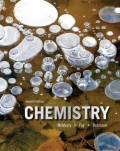
Concept explainers
Interpretation:
The balanced equation for the dissociation of Bronsted- Lowry acids in water should be determined.
Concept introduction:A Bronsted-Lowry acid is a species that reacts with water to donate a proton, H+:
A Bronsted-Lowry base is a species that reacts with water to accept a proton:
Answer to Problem 15.1P
Solution:
Explanation of Solution
The given species is
Here, the conjugate base is SO42-.
(c)
Interpretation:
The balanced equation for the dissociation of Bronsted- Lowry acids in water should be determined.
Concept introduction:A Bronsted-Lowry acid is a species that reacts with water to donate a proton, H+:
A Bronsted-Lowry base is a species that reacts with water to accept a proton:
Answer to Problem 15.1P
Solution:
Explanation of Solution
The given species is
The reaction is as follows:
Here, the conjugate base is H2O.
(d)
Interpretation:
The balanced equation for the dissociation of Bronsted- Lowry acids in water should be determined.
Concept introduction:A Bronsted-Lowry acid is a species that reacts with water to donate a proton, H+:
A Bronsted-Lowry base is a species that reacts with water to accept a proton:
Answer to Problem 15.1P
Solution:
Explanation of Solution
The given species is
The reaction is as follows:
Here, the conjugate base is NH3.
Want to see more full solutions like this?
Chapter 15 Solutions
EBK CHEMISTRY
 ChemistryChemistryISBN:9781305957404Author:Steven S. Zumdahl, Susan A. Zumdahl, Donald J. DeCostePublisher:Cengage Learning
ChemistryChemistryISBN:9781305957404Author:Steven S. Zumdahl, Susan A. Zumdahl, Donald J. DeCostePublisher:Cengage Learning ChemistryChemistryISBN:9781259911156Author:Raymond Chang Dr., Jason Overby ProfessorPublisher:McGraw-Hill Education
ChemistryChemistryISBN:9781259911156Author:Raymond Chang Dr., Jason Overby ProfessorPublisher:McGraw-Hill Education Principles of Instrumental AnalysisChemistryISBN:9781305577213Author:Douglas A. Skoog, F. James Holler, Stanley R. CrouchPublisher:Cengage Learning
Principles of Instrumental AnalysisChemistryISBN:9781305577213Author:Douglas A. Skoog, F. James Holler, Stanley R. CrouchPublisher:Cengage Learning Organic ChemistryChemistryISBN:9780078021558Author:Janice Gorzynski Smith Dr.Publisher:McGraw-Hill Education
Organic ChemistryChemistryISBN:9780078021558Author:Janice Gorzynski Smith Dr.Publisher:McGraw-Hill Education Chemistry: Principles and ReactionsChemistryISBN:9781305079373Author:William L. Masterton, Cecile N. HurleyPublisher:Cengage Learning
Chemistry: Principles and ReactionsChemistryISBN:9781305079373Author:William L. Masterton, Cecile N. HurleyPublisher:Cengage Learning Elementary Principles of Chemical Processes, Bind...ChemistryISBN:9781118431221Author:Richard M. Felder, Ronald W. Rousseau, Lisa G. BullardPublisher:WILEY
Elementary Principles of Chemical Processes, Bind...ChemistryISBN:9781118431221Author:Richard M. Felder, Ronald W. Rousseau, Lisa G. BullardPublisher:WILEY





